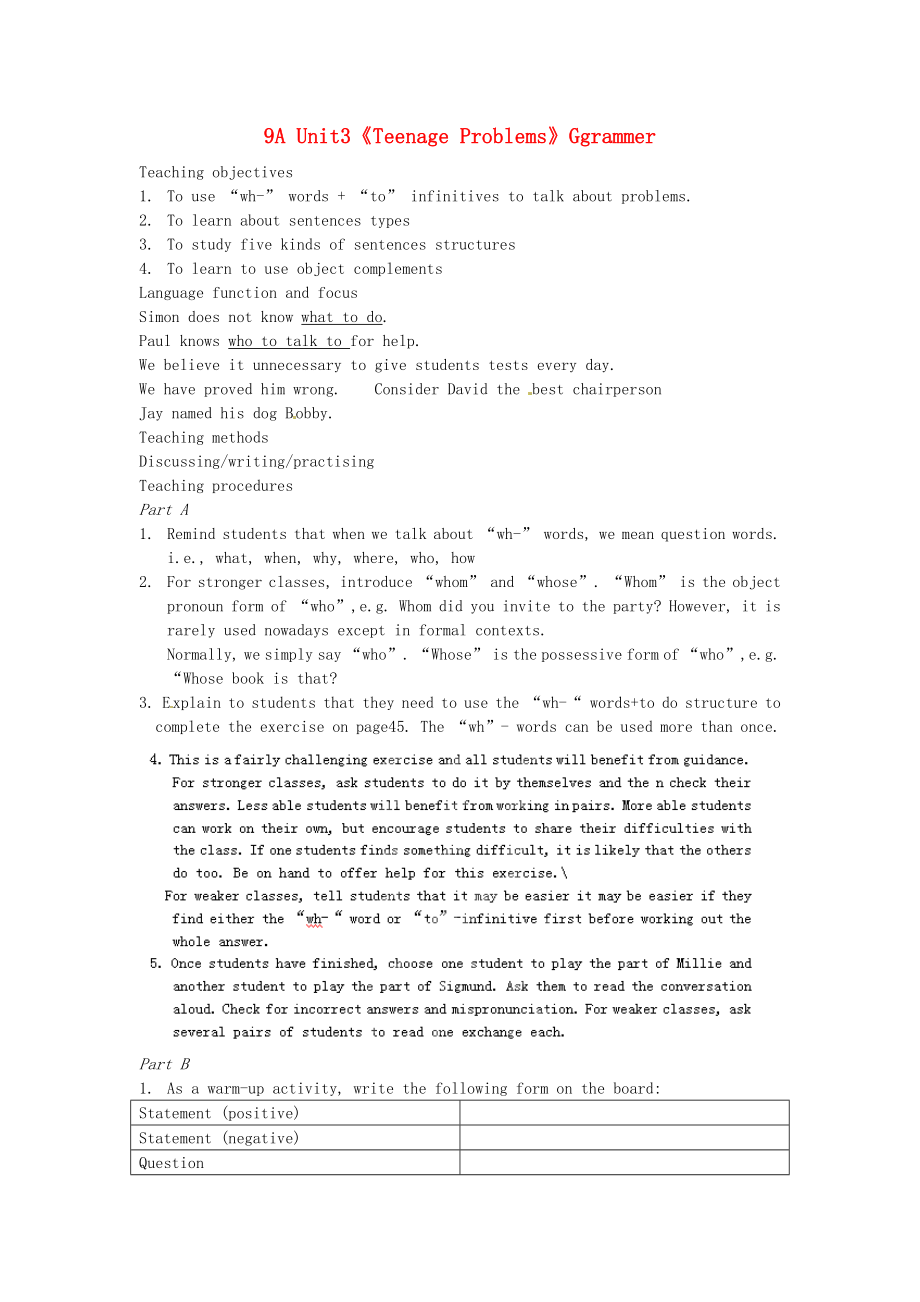《江蘇省宿豫區(qū)關(guān)廟中心學(xué)校九年級(jí)英語(yǔ)上冊(cè)9AUnit3TeenageProblemsGgrammer教學(xué)設(shè)計(jì)1牛津版》由會(huì)員分享�����,可在線閱讀�����,更多相關(guān)《江蘇省宿豫區(qū)關(guān)廟中心學(xué)校九年級(jí)英語(yǔ)上冊(cè)9AUnit3TeenageProblemsGgrammer教學(xué)設(shè)計(jì)1牛津版(2頁(yè)珍藏版)》請(qǐng)?jiān)谘b配圖網(wǎng)上搜索���。
1��、9A Unit3《Teenage Problems》Ggrammer
Teaching objectives
1. To use “wh-” words + “to” infinitives to talk about problems.
2. To learn about sentences types
3. To study five kinds of sentences structures
4. To learn to use object complements
Language function and focus
Simon does not know what
2�、to do.
Paul knows who to talk to for help.
We believe it unnecessary to give students tests every day.
We have proved him wrong. Consider David the best chairperson
Jay named his dog Bobby.
Teaching methods
Discussing/writing/practising
Teaching procedures
Part A
1. Remind students that
3�����、when we talk about “wh-” words, we mean question words. i.e., what, when, why, where, who, how
2. For stronger classes, introduce “whom” and “whose”. “Whom” is the object pronoun form of “who”,e.g. Whom did you invite to the party? However, it is rarely used nowadays except in formal contexts.
Nor
4��、mally, we simply say “who”. “Whose” is the possessive form of “who”,e.g. “Whose book is that?
3. Explain to students that they need to use the “wh-“ words+to do structure to complete the exercise on page45. The “wh”- words can be used more than once.
Part B
1. As a warm-up activity, write the fo
5�、llowing form on the board:
Statement (positive)
Statement (negative)
Question
Imperative
Exclamation
2. Ask students to make up a sentence in each blank on the right according to the requirement on the left. Students make up their own sentences on a piece of paper. Less able stude
6、nts can work in pairs. Encourage more able students to work on their own.
3. Ask a student to come to the front of the class and write the sentence in the right column. If the answer is correct, he / she can choose the next students to the front to continue. If not, you choose the next student.
7�����、4. Go through the table at the top on page 46. Ask students if they have any questions. Make sure they understand the four types of sentences.
5. Tell students the basic use of a statement is to give information, e.g., “Millie wrote to Sigmund Friend for advice.” The negative form of this statemen
8、t is “Millie did not write to Sigmund Friend for advice.” Some statements do more than give information. They can also be used to ask for information, express approval or sympathy, thank someone, give orders or provide an offer.
Tell students the basic use of a question is to ask for information
9��、, e.g., “When do you usually go to school?” We can also use questions in other ways, such as making requests, e.g., “Can I have a cup of tea, please?” making suggestions, e.g., “Shall we bring more water?”, making offers, e.g., “Can I help?” or asking for permission, e.g., “May I come in?”
Tell stu
10�、dents that the imperative form is the base form of the verb. The imperative is used to give orders or to get someone to do something. When giving orders, you expect the person will obey. For example, when I say “Stop making so much noise!”, I mean that “You should stop making noise.” An imperative c
11�����、an also be used to give suggestions, warnings, instructions, invitations or good wishes.
Tell students that an exclamation is a sentence spoken with emphasis. We can use “what” or “how” to start an exclamation, e.g.,
“How lucky we are today!”
“What a lucky day!”
6. Explain to students that in the exercise on page 46 they must identify the different types of the sentences and write the correct answers in the blanks. This is a fairly simple exercise. Students can work out their own.
7. Once students have finished, ask the class to check the answers with you.
Homework:<<補(bǔ)充習(xí)題>>
 江蘇省宿豫區(qū)關(guān)廟中心學(xué)校九年級(jí)英語(yǔ)上冊(cè)9AUnit3TeenageProblemsGgrammer教學(xué)設(shè)計(jì)1牛津版
江蘇省宿豫區(qū)關(guān)廟中心學(xué)校九年級(jí)英語(yǔ)上冊(cè)9AUnit3TeenageProblemsGgrammer教學(xué)設(shè)計(jì)1牛津版

